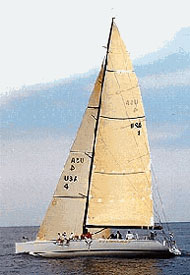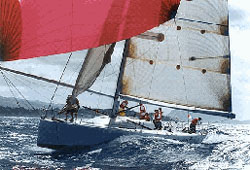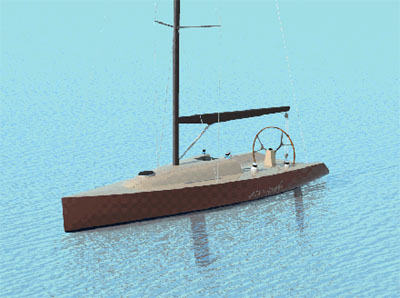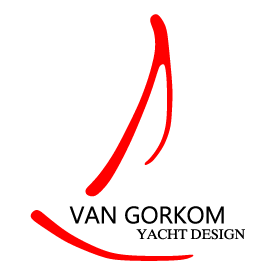Designing for the Transpac…Past, Present & Future

What could be seen as a direct reaction to an age of prolific one-design where open forums for the development of new and innovative ideas in sail boat design are becoming increasingly scarce, there is a growing trend developing in event driven classes, particularly offshore events. A prime example of this is the Transpac Race, a 2225 mile ocean classic held every two years. The inaugural regatta was sailed in 1906 and since then there has been 41 runnings of this West Coast Classic with 2003 being the 42nd. The event is now raced every other year with the Pacific Cup (San Francisco to Hawaii) on the alternate year.
The race starts from Los Angeles, California with typically two to three days of beating to windward until the boats reach an invisible mark defining the Pacific Trade Winds. At this point the crews crack sheets, set their kites and enjoy ten days of exhilarating reaching conditions in long, blue-water, Pacific Ocean swells with the final destination being the tropical shores of Hawaii. This event boasts of a unique camaraderie between its participants where owners and crews share a common bond and an uncrowded ocean.
The Transpac Race is steeped in tradition and prestige with the brass ring being the coveted “Barn Door” prize awarded to the monohull with the fastest elapsed time. The prize is so named for the giant piece of Koa wood that makes up this majestic trophy. In passed years record breaking performances have been logged by such famous names as Morning Star, Ticonderoga, Black Fin, Windward Passage, Merlin and Pywacket to name just a few.
However, to paraphrase the organizers (the Transpac Yacht Club), “the event has never been locked in time.” A fair statement, given the fact that it has spawned some significant developments in sail boat design over the years. The emphasis on breaking the previous race record and being the first across the finish line at Diamond Head Light lead Bill Lee to design Merlin. This 68 foot rocket set a new trend in motion that would become the ULDB “Sled” class. Soon after, a number of lean, mean and light racing machines (such as the Santa Cruz 70s) were making their debut on the start line of the Transpac Race.
In recent years the ULDB concept reached a whole new level with the creation of the Turbo Sleds. These ocean greyhounds were at first modified Santa Cruz 70s, but more recently a new breed of 76 footers exploded onto the ocean racing circuit, such as Phillip Kahn’s Pegasus and Roy Disney’s Pyewacket designed by the Riechel Pugh office. However, with the advent of the high profile “big boats” came the big budgets necessary to campaign them. And with so much emphasis being placed on breaking the race record and winning the “Barn Door,” there was actually a decline in participation in the smaller boat classes that typically race for the less glorified, overall win on corrected time.

Recognizing this, and wanting to bring the race back to the masses, the principal organizers, along with a group of West Coast designers headed up by Bill Lee, began to hammer out a new “box rule” concept for a class of smaller boats in the 40 to 50 foot range. The result was that in 2000 the newly formed Transpac 41/52 Rule was introduced. The objective of the new sail boat design rule was to create incentive to achieve line honors for the smaller boats’ classes. The respective classes would compete on a relatively level playing field and would be no less capable offshore than their larger cousins, yet still be versatile enough to be raced at the club level.
The new rule produced a wave of interest and it wasn’t long before designs were commissioned with the goal of reaching the starting line for 2001. The 41st running of the “Aloha Classic” saw some of the closest racing in Transpac history between the “Turbo Sleds” with Pegasus first to finish. The debut of two new Transpac 52s proved that the Transpac box rule concept was a winner with JBird III, designed by Alan Andrews, winning its class and beating some of the older SC 70s. The overall winner on corrected time was a Sydney 41 demonstrating that there was plenty of potential for a 41 foot class. It was also gratifying for the race organizers that, although a lot was written about Pegasus’ exciting first-to-finish run, it seemed more coverage was given to the other classes and how they faired.
The basic premise of the Transpac 41/52 Rule is relatively simple with an emphasis placed on reliability and self-sufficiency. The authors of the rule freely admit it is type-forming, with the potential of creating level classes (no time allowances) for both offshore and inshore events. Strict controls are placed on speed-producing factors such as length, minimum displacement, maximum draft and maximum sail area (see table). However, freedom to develop hull and foil geometries, construction, and interior, deck and rigging arrangements are allowed (within the confines of the rule).

The rule also specifies compliance with ORC Safety Recommendations for Offshore Sailing, American Bureau of Shipping guidelines for the development of structural scantlings, and requires each yacht to have a valid IMS certificate. Both the 41s and 52s have runnerless fractional rigs and fly masthead spinnakers and huge masthead Code 0 headsails. Inboard water-cooled diesel engines are required and only the 41 footers will be permitted to carry internal water ballast. Rules for the new classes also permit the “grandfathering” of similar existing boats into the class, although their displacement can not be lighter nor their sail area larger.
With the emphasis on boats that can cross oceans fast and in safety, the 42nd running of the Transpac will see the introduction of a whole new breed of maxi, the maxZ86 Class, and no less than five Transpac 52s will be racing. There is also a rapidly growing interest in the cost-effective Transpac 41 where owners are assured of tight competitive racing for relatively less money and somewhat more versatility. And while many of the owners of the larger yachts need little convincing, the prime motivator for this new breed of smaller boats appears to be distance racing, for which they are sure to become the new chapter in this colorful history of the race known as the Transpac.
